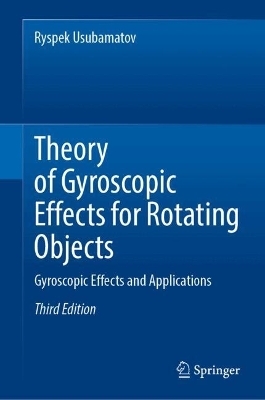
Theory of Gyroscopic Effects for Rotating Objects
Springer International Publishing (Verlag)
978-3-031-74200-2 (ISBN)
- Noch nicht erschienen - erscheint am 25.01.2025
- Versandkostenfrei innerhalb Deutschlands
- Auch auf Rechnung
- Verfügbarkeit in der Filiale vor Ort prüfen
- Artikel merken
This book highlights an analytical solution for the dynamics of axially rotating objects. It also presents the theory of gyroscopic effects, explaining their physics and using mathematical models of Euler's form for the motion of movable spinning objects to demonstrate these effects. The major themes and approaches are represented by the spinning disc and the action of the system of interrelated inertial torques generated by the centrifugal and Coriolis forces, as well as the change in the angular momentum. The interrelation of inertial torques is based on the dependency of the angular velocities of the motions of the spinning objects around axes by the principle of mechanical energy conservation. These kinetically interrelated torques constitute the fundamental principles of the mechanical gyroscope theory that can be used for any rotating objects of different designs, like rings, cones, spheres, paraboloids, propellers, etc. Lastly, the mathematical models for the gyroscopic effects are validated by practical tests. This book is highlighted in its already third edition.
The new edition comprises many new sections for several chapters or new chapters. The most important ones are:
- Chapter 3 includes a mathematical model for the section inertia torques acting on the spinning annulus and thin ring. The latter does not have a full solution because the handbooks comprise simplified parameters that cannot be used for an exact solution.
- Chapter 4 offers mathematical model for the arbitrary disposition of the spinning object in space that shows the action of the additional four inertial torques acting on the third axis and new dependencies of gyroscope motions.
- Chapter 7 now presents mathematical model for the gyroscope nutation with a full solution. The known mathematical model presents a partial solution due to the complexity of the problem.
Dr. Ryspek Usubamatov graduated from the Moscow State Technical University after N. Bauman with a professional engineer in Mechanical and Manufacturing Engineering and Ph.D. in Industrial Engineering. He obtained Dr. Tech. Sc. in Academy of Sciences of Kyrgyzstan. His industrial experience includes work as a registered professional engineer in machine tools design at the Bishkek Engineering Plant of Kyrgyzstan. Academic professional experience has involved teaching at the Universities of Kyrgyzstan and Malaysia. His major areas of research are mechanical, manufacturing, and industrial engineering where published 8 books around 400 manuscripts, and 61 patents of inventions. He is the author of two fundamental works, "Productivity Theory for Industrial Engineering", Taylor & Francis, 2018, and "Theory of Gyroscopic Effects, for Rotating Objects", Springer, 2022.
Preface.- Abstract.- Nomenclature.- Gyroscopic effects in engineering.- Acceleration analysis of rotating object.- Inertial forces acting on simple spinning objects.- Properties and specifies of gyroscopic torques.- Mathematical models for motions of a gyroscope suspended from the flexible cord.- Mathematical models for motions of a gyroscope with one side support.- Mathematical models for the top motions and gyroscope nutation.- Gyroscopic effects of deactivation of inertial forces.- Appendix A.- Appendix B.
| Erscheint lt. Verlag | 25.1.2025 |
|---|---|
| Zusatzinfo | XVIII, 330 p. 90 illus., 3 illus. in color. |
| Verlagsort | Cham |
| Sprache | englisch |
| Maße | 155 x 235 mm |
| Themenwelt | Mathematik / Informatik ► Mathematik ► Angewandte Mathematik |
| Naturwissenschaften ► Physik / Astronomie ► Mechanik | |
| Schlagworte | Coriolis forces • Euler's form • Euler’s form • Gyroscope nutation • Gyroscopic torques • Inertial forces • Orbital Flight • Spinning cylinder • Spinning disc • Spinning objects • Tippe top inverstion |
| ISBN-10 | 3-031-74200-1 / 3031742001 |
| ISBN-13 | 978-3-031-74200-2 / 9783031742002 |
| Zustand | Neuware |
| Informationen gemäß Produktsicherheitsverordnung (GPSR) | |
| Haben Sie eine Frage zum Produkt? |
aus dem Bereich


